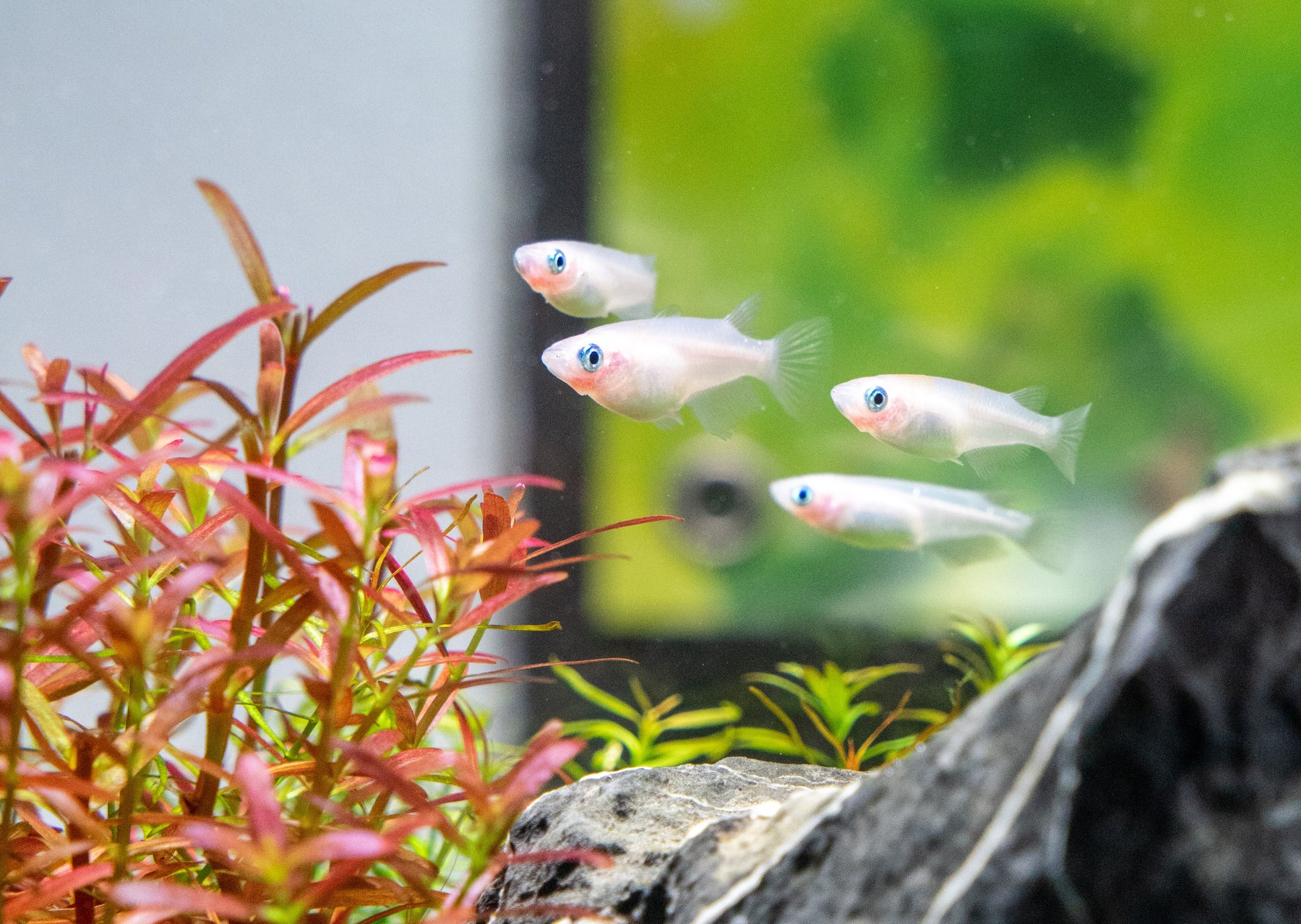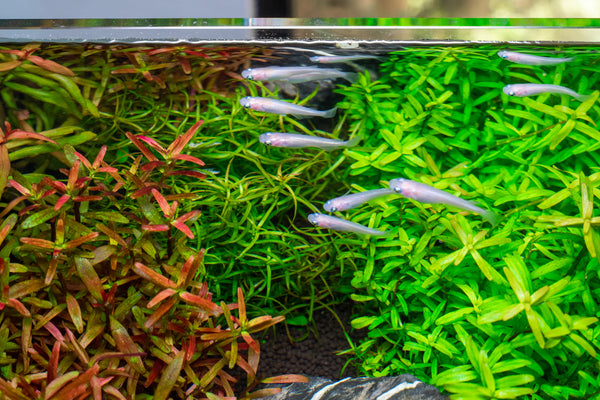
Japanese Rice Fish Care Guide
People who enjoy keeping fish in their freshwater aquariums might find it challenging to find the perfect species. A school of Japanese Rice Fish or singular fish like gourami are an excellent choices. In this article, we will tell you about very beautiful and hardy ricefish. It's a relatively easy fish species to keep, display vibrant colors, and bring an interesting personality to any scape. We have many different species of Japanese Rice Fish available in our store with a 100% live arrival guarantee for all orders.

About Japanese Rice Fish
The Japanese Rice Fish (Oryzias Latipes) also known as the medaka, is a member of genus Oryzias (ricefish) in the subfamily Oryziinae. These fish have the similar features to other popular aquarium inhabitants like guppies or neon tetras. They are easy to care for and compatible with many other species you may want to keep in your planted aquarium. Although often overlooked for planted tanks, aquarists have kept these fish in aquariums for centuries.
Japanese Rice Fish are native to East Asia, and can be found in Japan, Laos, Vietnam, Taiwan, eastern Korea, eastern China in rice paddies, marshes, ponds, slow-moving streams and tide pools. Its name contains "rice" because it is often found in rice fields. They are drawn to shallow, warm locations with slow-moving rivers or stagnant water with muddy substrate and an abundance of aquatic plants (meaning that they are perfect for planted tanks!)
Adult animals can grow up to 3.5 centimeters or 1.5 inches in length. They range in coloration, one of the most popular being the Pearl Galaxy medaka ricefish. When light hits them just right, the color of the scales can sparkle a silvery or blue tint, making them appear opalescent. Males tend to be generally more brightly colored and have longer dorsal and anal fins than females. Females are bigger, although they are not as bright as males.
They are very tranquil, loosely-schooling fish and can easily live with other non-aggressive species of comparable size. The typical life expectancy in a home aquarium is around 3-4 years.
Rice Fish Care
Tank Requirements
The minimum tank size for ricefish is 10 gallons for a school of 6. Keep in mind that they are a freshwater schooling fish that live in groups naturally. It is recommended to keep ricefish in schools of at least 6 or more because they might become anxious, are more prone to jumping, and may lose their appetite if left alone. Consider adding a lid to your tank because they can easily jump out of the aquarium.
You will need a good filtration system for your planted tank. Medaka rice fish cannot thrive in dirty, unbalanced water. Consider purchasing a canister filter, like the UNS Delta 60, to ensure that you are keeping a healthy environment for them.
Like with any other freshwater fish, it is recommended to recreate a natural environment for ricefish in your aquarium. Make sure your tank is properly cycled prior to adding your ricefish. Use natural driftwood and plenty of aquarium plants to create a comfortable habitat for them. Ricefish are entirely harmless to live aquatic plants.
Although bright LED lighting will let you appreciate your fish's radiant shine, ricefish are not fond of intense lighting. It's recommended to use a dimmable light (like the ONF Flat Nano) or a low-intensity light (like the Twinstar B Line.) Consider adding floating plants like Water Lettuce or Red Root Floaters to give your ricefish some shade. It's also recommend to include a few hiding spaces in your scape, such as appropriate hardscape or a thicket of aquarium plants.
Water Parameters
Medakas need clean water, so make sure to keep up with weekly 20-25% water changes to ensure healthy water conditions. Always make sure to dechlorinate your water prior to adding it to the aquarium. Heavy metals and chlorine can be found in tap water, and these contaminants can be harmful even to hardy ricefish. You can find an appropriate aquarium conditioners in our water treatment collection to make your water hospitable for your fish.
Ricefish are considered "coldwater fish" and prefer to live in a cold environment. No heater necessary! Suitable water temperatures for Japanese rice fish is between 61 to 75°F. Although, they are known to survive temperatures as low as 37°F. The recommended pH is 7.0-8.0.
Tank Mates
The behavior of ricefish is very serene and similar to other small community fish species. It is preferable to choose fish that are proportionate to their size. Seluang fish, pseudomugil, cory catfish, neon tetras, and guppies are all excellent choices. You can also freely add shrimps and snails. It is better not to put ricefish with violent species at all. Ricefish usually have an excellent relationship with their relatives. Males battling for female attention can be aggressive occasionally, but these fights usually do not result in severe injuries.
Rice Fish Diet
Japanese Rice Fish are omnivores and may consume any form of dry food, including pellets and flakes. You can also feed them blood worms, vegetables, mosquito larvae as a treat. Feeding them a small amount twice a day is recommend.
Keep in mind that the food must be tiny enough to fit into their little mouths. Micro food is designed to be quickly eaten and digested, which helps to minimize the amount of unwanted bioload in your aquarium. It can be pellets, sticks, granules, and chips. They just have to be small enough.
Breeding Rice Fish
Japanese rice fish are easy to breed. If you'd like to breed your ricefish, make sure that the ricefish are the only livestock in the aquarium. In a community aquarium, the other inhabitants may eat all their eggs unless you have a lot of plant thickets. It is preferable to get a separate spawning fish tank with lots of floating plants to provide lots of cover. They prefer to lay their eggs on bushy plants or grassy areas.
Usually, spawning occurs in the spring or summer months. Help them better prepare by feeding them a diet that's higher in protein, such as blood worms. Males start defending their own small territory and attracting females. The female medaka fish will lay the egg, which gets stuck in its anal fin, which is then fertilized by the male. After fertilization, she will lay a cluster of eggs and swim around with that cluster attached to her for several minutes before finding a safe place to drop them, which is usually on the plant thickets or large leaves.
The female may lay eggs each day for a couple of weeks if proper conditions are met. The incubation period may take up to three weeks, but it usually happens faster. The hatched fry can be fed with infusoria or liquid fry food. Ricefish become self-sufficient shortly after hatching and get sexually mature about 4 to 6 months after birth.

Although, Japanese Rice Fish are an often overlooked when stocking planted tanks, but these fish always bring life and color to the right aquascape. Check out the 6 different species of Japanese rice fish for sale HERE.
Tell us - Have you kept Medakas before? If not, would you like to one day? Comment your thoughts!
If you have any questions regarding this article, please DM us on Facebook or Instagram so we can assist you! @buceplant







Comments
Leave a comment